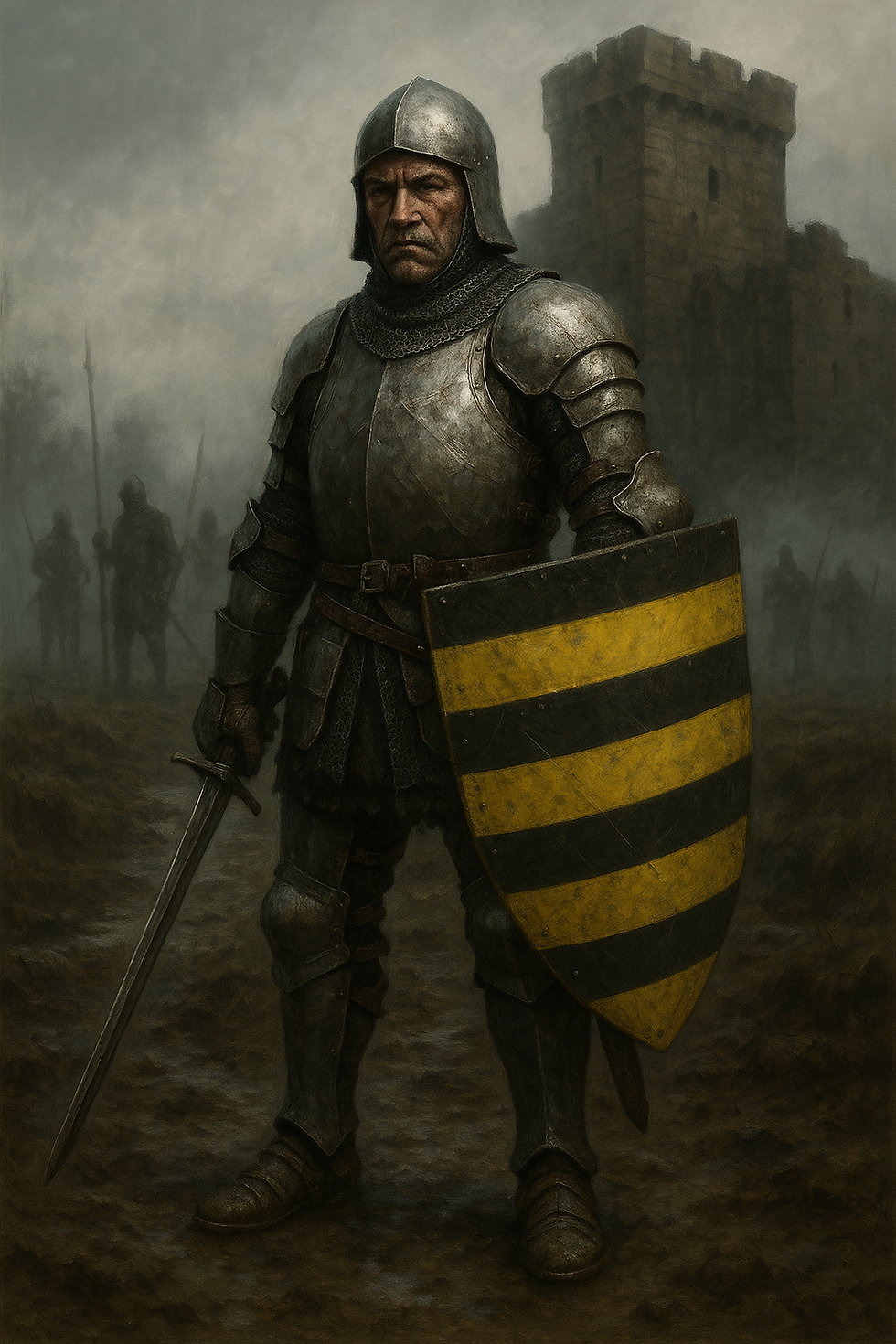Who Was Sir Walter de Selby?
- nickmclean18
- Jun 10
- 4 min read
The Last Man at the Gate
History loves its clean-cut heroes. The ones with polished armour, pious motives, and great hair. However, it tends to forget the men who did the dirty work. The ones who didn’t ride into glory but stood ankle-deep in mud, holding the line when everyone else was off chasing banners and dreams.
Sir Walter de Selby was one of the latter. And by all accounts, you’d have been a fool to cross him.
A Life of Mild Treason and Aggressive Survival
Walter wasn’t born into nobility. He wasn’t destined for greatness. He simply had a knack for surviving in a world where that alone was a form of genius.
He kicked off his career by siding with Sir Gilbert de Middleton, a man who thought “strategy” meant robbing papal cardinals on the open road. Which, to be fair, does get you noticed. Unfortunately, it also gets you hanged, drawn, and quartered, which is exactly what happened to Middleton.
Selby, displaying the situational awareness of a cockroach in a flood, fled to Scotland.

A Man of Many Loyalties (All Subject to Change as Required)
When Robert the Bruce took Mitford Castle, he appointed Selby as castellan. In theory, this meant Selby was now a man of Scotland. In practice, it meant he was watching the clock, waiting for a better offer.
That offer came during a truce in 1321, when Selby handed Mitford back to England in exchange for the promise of getting his lands returned. Edward II, who specialised in holding grudges and losing wars, refused. Selby was chucked in the Tower of London for six years, which was probably less punishment and more career detour.
He was finally released in 1327, thanks to a political coup and a convenient change of management. He secured a royal pardon for, and I quote, “all felonies, robberies, homicides and other things,” which is possibly the most beautifully vague admission of guilt in English legal history. Whatever he’d done, and it was probably a lot, they let him off with a shrug
.
From Outlaw to Border Management, Becoming Sir Walter de Selby
Selby didn’t just walk free. He walked into royal favour. By 1332, he was helping Edward Balliol, Scotland’s very own discount king, and earned himself the barony of Plenderleith. Five years later, he was in command of Bothwell Castle. It lasted about as long as a paper roof in a rainstorm. The Scots took it, smashed it up, and went home. Welcome to the Borders.
In 1345, Selby was investigating stolen Scottish cattle. Not glorious, but clearly his kind of work. Murky, unofficial, probably violent, and very unlikely to involve the law.

Liddel Strength, 1346
By now, Selby had settled into his role as the Crown’s man in the north. The kind of man they posted to places other people couldn’t pronounce. In 1346, he was holding Liddel Strength, a small, ugly fort jammed against the Scottish frontier. It was isolated, weather-beaten, and utterly miserable. Which meant it was perfect for Selby.
When word came that Sir William Douglas was riding south with five hundred mounted maniacs, nobody expected a last stand. Except Selby. He didn’t panic and he didn’t call for help. He just gritted his teeth and got on with the job at hand.
Sir Walter, along with the entire garrison of Liddel, (if you believe the Lanercost Chronicle) was butchered upon eventually surrendering the fortress of Liddel Strength.
No Songs, No Statues
There are no glowing tributes to Sir Walter de Selby. No tapestries, no plaques and no heartfelt speeches in Parliament. All he left behind was a patchy trail of violence, loyalty-swapping, and suspicious pardons.
But the fact is, Selby held the line. Not because he believed in England or justice or any of that nonsense, but because he knew what happened if you didn’t. People like him weren’t in it for honour. They were in it to stay alive.
And somehow, he managed that longer than most.
The Right Kind of Wrong
Selby doesn’t belong in a romance. He belongs in a dimly lit room with a sharp knife and no witnesses. He wasn’t a hero. But when the Scots were burning towns and the Crown needed someone unpleasant in a remote northern hole, they called Walter.
He got the job done, or died trying and that was good enough.
So who was Sir Walter de Selby? He was a tough, pragmatic leader who did what he had to in order to survive and mostly, he did this very well.
Sir Walter de Selby features in A King’s Gamble: The Neville’s Cross Campaign, 1346. He’s not the main character. But he’s the kind of man history rests on. The forgotten man in the background. This post is part of a blog series exploring the forgotten rogues, warhorses, and dangerous has-beens of the medieval Anglo-Scottish border wars.
Next time: maybe a coward with a crown. Or a priest with a grudge. Depends who annoys me first.

Comments